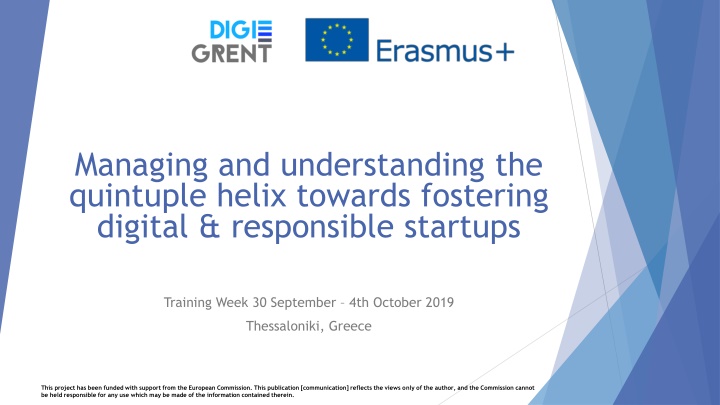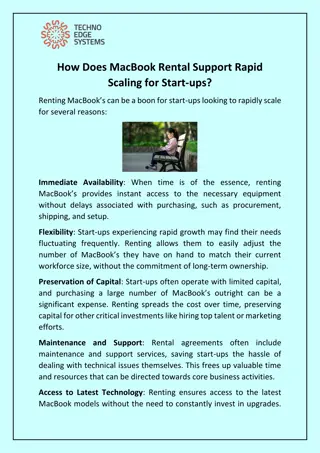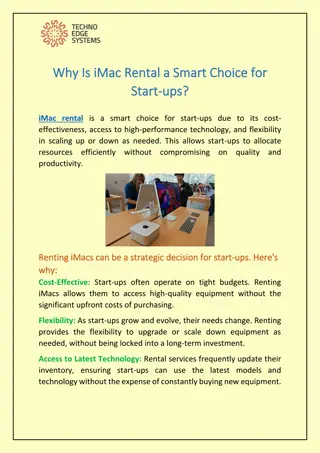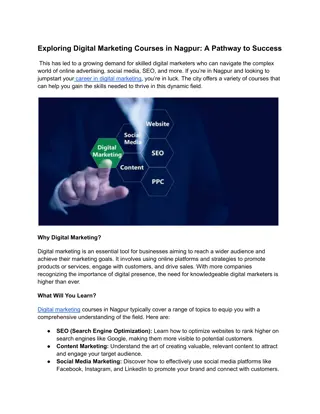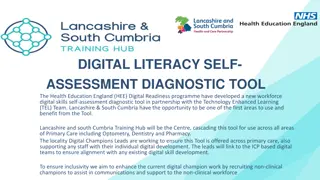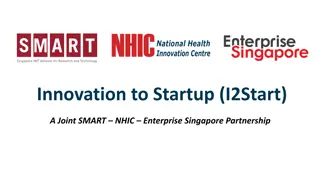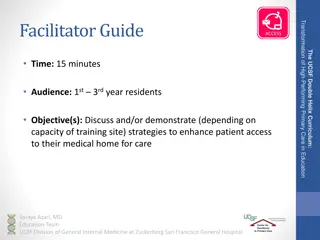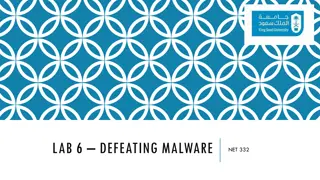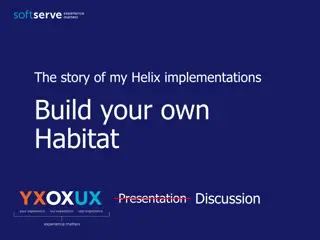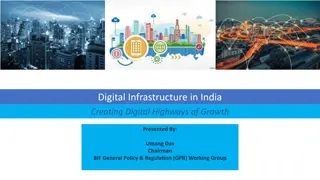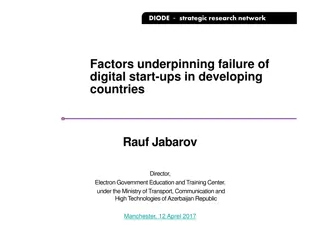Managing Quintuple Helix for Digital Start-ups Training
Fostering eco-friendly, responsible, and digital business models and start-ups through Quintuple Helix approach. Explore the origin and evolution from the Triple Helix model of innovation by Etzkowitz and Leydesdorff. Learn about academia, industry, governments, and networking management towards corporate social responsibility.
Download Presentation

Please find below an Image/Link to download the presentation.
The content on the website is provided AS IS for your information and personal use only. It may not be sold, licensed, or shared on other websites without obtaining consent from the author.If you encounter any issues during the download, it is possible that the publisher has removed the file from their server.
You are allowed to download the files provided on this website for personal or commercial use, subject to the condition that they are used lawfully. All files are the property of their respective owners.
The content on the website is provided AS IS for your information and personal use only. It may not be sold, licensed, or shared on other websites without obtaining consent from the author.
E N D
Presentation Transcript
Managing and understanding the quintuple helix towards fostering digital & responsible startups Training Week 30 September 4th October 2019 Thessaloniki, Greece This project has been funded with support from the European Commission. This publication [communication] reflects the views only of the author, and the Commission cannot be held responsible for any use which may be made of the information contained therein.
Contents 1. Quintuple Helix Eco-friendly (EF) / Responsible (R) and Digital (D) Business Models / Start-ups 4. ICT 2. Networking Management 3. Corporate Social Responsibility This project has been funded with support from the European Commission. This publication [communication] reflects the views only of the author, and the Commission cannot be held responsible for any use which may be made of the information contained therein.
Quintuple Helix 1. Quintuple Helix Eco-friendly (EF) / Responsible (R) and Digital (D) Business Models / Start-ups 4. ICT 2. Networking Management 3. Corporate Social Responsibility This project has been funded with support from the European Commission. This publication [communication] reflects the views only of the author, and the Commission cannot be held responsible for any use which may be made of the information contained therein.
Triple Helix the origin of Quintuple Helix The triple helix model of innovation refers to a set of interactions between academia, industry and governments, to foster economic and social development This framework was first theorized by Henry Etzkowitz and Loet Leydesdorff in the 1990s The triple helix model of Innovation is based on the interactions between the three following elements and their associated initial role : universities providing education to individuals and engaging in basic research industries producing commercial goods governments that are regulating markets 1. "The Triple Helix Concept". Stanford University Triple Helix Research Group. 11 July 2011. 2. Leydesdorff, Loet (2012). "The Knowledge-Based Economy and the Triple Helix Model" . University of Amsterdam, Amsterdam School of Communications Research. 3. Leydesdorff, Loet; Lawton Smith, Helen. "The Triple Helix in the context of global change: dynamics and challenges" This project has been funded with support from the European Commission. This publication [communication] reflects the views only of the author, and the Commission cannot be held responsible for any use which may be made of the information contained therein.
Triple Helix the origin of Quintuple Helix TH1: etatistic model of UIS; TH2: laissez-faire policy of UIS; TH3: Triple Helix model of UIS STATE STATE STATE UNI IND IND UNI IND UNI Source: Etzkowitz and Leydesdorff, (2000) This project has been funded with support from the European Commission. This publication [communication] reflects the views only of the author, and the Commission cannot be held responsible for any use which may be made of the information contained therein.
Quadruple and Quintuple Innovation Helix The quadruple along with the quintuple innovation helix framework was co-developed by Elias G. Carayannis and David F.J. Campbell They extended and expanded substantially the triple helix model of Innovation, as the framework introduces civil society and the environment as pillars and focal points of policy and practice This project has been funded with support from the European Commission. This publication [communication] reflects the views only of the author, and the Commission cannot be held responsible for any use which may be made of the information contained therein.
The five helices Apart from active human agents, the most important constituent element of the quintuple helix is knowledge, which, through a circulation between societal subsystems, changes to innovation and know-how in a society and for the economy. The quintuple helix visualizes the collective interaction and exchange of this knowledge in a state by means of the following five subsystems (i.e., helices): education system economic system natural environment media-based and culture-based public (also civil society ) and the political system. 1. Barth, Thorsten D. (2011). "The Idea of a Green New Deal in a Quintuple Helix Model of Knowledge, Know-How and Innovation". International Journal of Social Ecology and Sustainable Development. 2 (1): 6 2. Carayannis, Elias G.; Campbell, David F.J. (2010). "Triple Helix, Quadruple Helix and Quintuple Helix and How Do Knowledge, Innovation and the Environment Relate To Each Other?: A Proposed Framework for a Trans-disciplinary Analysis of Sustainable Development and Social Ecology". International Journal of Social Ecology and Sustainable Development. 1 (1): 46 48, 62. This project has been funded with support from the European Commission. This publication [communication] reflects the views only of the author, and the Commission cannot be held responsible for any use which may be made of the information contained therein.
The five helices - continued Each of the five helices has an asset at its disposal, with a societal and scientific relevance. The education system defines itself in reference to academia, universities, higher education systems, and schools. In this helix, the necessary human capital (e.g., students, teachers, scientists/ researchers, academic entrepreneurs, etc.) of a state is being formed by diffusion and research of knowledge. The economic system consists of industry/industries, firms, services and banks. This helix concentrates and focuses the economic capital (e.g., entrepreneurship, machines, products, technology, money, etc.) of a state. The natural environment subsystem is decisive for sustainable development and provides people with natural capital (e.g., resources, plants, variety of animals, etc.). The media-based and culture-based public subsystem integrates and combines two forms of capital. This helix has, through the culture-based public (e.g., traditions, values, etc.), a social capital. In addition, the helix of media-based public (e.g., television, internet, newspapers, etc.) contains capital of information (e.g., news, communication, social networks). The political system formulates the will, i.e., where the state is heading, thereby also defining, organizing, and administering the general conditions of the state. Therefore, this helix has political and legal capital (e.g., ideas, laws, plans, politicians, etc.). This project has been funded with support from the European Commission. This publication [communication] reflects the views only of the author, and the Commission cannot be held responsible for any use which may be made of the information contained therein.
Circulation of knowledge 1. Carayannis, Elias G.; Barth, Thorsten D.; Campbell, David F.J. (2012). "The Quintuple Helix innovation model: global warming as a challenge and driver for innovation". Journal of Innovation and Entrepreneurship. 1 (2): 2. This project has been funded with support from the European Commission. This publication [communication] reflects the views only of the author, and the Commission cannot be held responsible for any use which may be made of the information contained therein.
Circulation of knowledge Step 1: When investments flow into the education helix to promote sustainable development, they create new impulses and suggestions for knowledge creation in the education system. Therefore, a larger output of innovations from science and research can be obtained. Simultaneously, teaching and training improve their effectiveness. The output that arises from human capital for sustainable development is then an input into the economic system helix. Step 2: Through the input of new knowledge via human capital into the economic system helix, the value of the knowledge economy consequently increases. Through the enhancement of knowledge, important further production facilitates and develops opportunities for a sustainable, future-sensitive green economy, based on knowledge creation. This knowledge creation realizes in the economic system new types of jobs, new green products and new green services, together with new and decisive impulses for greener economic growth. In this subsystem, new values, like corporate social responsibility, are demanded, enabling and supporting a new output of know-how and innovations by the economic system into the natural environment helix. This project has been funded with support from the European Commission. This publication [communication] reflects the views only of the author, and the Commission cannot be held responsible for any use which may be made of the information contained therein.
Circulation of knowledge Step 3: This new sustainability as an output of the economic system is a new input of knowledge in the natural environment helix. This new knowledge communicates to nature and results in less exploitation, destruction, contamination, and wastefulness. The natural environment can, thus, regenerate itself and strengthen its natural capital, and humanity can also learn from nature via new knowledge creation. The goal of this helix is to live in balance with nature, to develop regenerative technologies, and to use available, finite resources sustainably. Here, natural science disciplines come into play, forming new green know-how. This know-how is then an output of the natural environment subsystem into the public helix. Step 4: The output of the natural environment results in an input of new knowledge about nature and a greener lifestyle for the media-based and culture-based public helix. Here, the media-based public receives information capital, which spreads through the media information about a new green consciousness. This capital should provide incentives on how a green lifestyle can be implemented in a simple, affordable, and conscious way, i.e., knowledge creation. This knowledge creation promotes the social capital of the culture-based public, on which a society depends for sustainable development. This know-how output then serves as new input, about the wishes, needs, problems, or satisfaction of citizens, for the political system helix. Step 5: The input of knowledge into the political system is the know-how from the media-based and culture-based public together with the collective knowledge from the three other subsystems of society. Important discussions on this new knowledge in the political systems are necessary impulses for knowledge creation. The goal of this knowledge creation is political and legal capital, making the quintuple helix model more effective and more sustainable. Consequently, there is an output of suggestions, sustainable investments, and objectives. This leads to the circulation of knowledge back into the education system. This project has been funded with support from the European Commission. This publication [communication] reflects the views only of the author, and the Commission cannot be held responsible for any use which may be made of the information contained therein.
Quintuple Helix vs Eco-friendly/Responsible and Digital Business Models EF Which elements of the Quintuple Helix influence Eco-friendly Business Models / Start-ups ? In what way? D Which elements of the Quintuple Helix influence Digital (D) Business Models / Start-ups ? In what way? (EF)/ Responsible (R) This project has been funded with support from the European Commission. This publication [communication] reflects the views only of the author, and the Commission cannot be held responsible for any use which may be made of the information contained therein.
Quintuple Helix examples and further reading Carayannis, Elias G.; Barth, Thorsten D.; Campbell, David F.J. (2012). "The Quintuple Helix innovation model: global warming as a challenge and driver for innovation". Journal of Innovation and Entrepreneurship. 1 (2): 2 https://innovation-entrepreneurship.springeropen.com/track/pdf/10.1186/2192- 5372-1-2 Social Seeds, Interreg Europe. Methodology and Good practices on quintuple helix cooperations: Making better use of social entrepreneurship collaborations in policy improvements https://www.interregeurope.eu/fileadmin/user_upload/tx_tevprojects/library/file _1536063863.pdf This project has been funded with support from the European Commission. This publication [communication] reflects the views only of the author, and the Commission cannot be held responsible for any use which may be made of the information contained therein.
Networking 1. Quintuple Helix Eco-friendly (EF) / Responsible (R) and Digital (D) Business Models / Start-ups 4. ICT 2. Networking Management 3. Corporate Social Responsibility This project has been funded with support from the European Commission. This publication [communication] reflects the views only of the author, and the Commission cannot be held responsible for any use which may be made of the information contained therein.
Networking the process of building a network of contacts through continuous relationships it is based on the use of everyday experience of relationships with people who live around us and with whom we have daily contact Networking is about: Networking is NOT about: Building strong, trustful, mutually beneficial relationships! soliciting virtual contacts only A way to achieve goals, grow business and get to the next rung of the business ladder together about the large number of contacts manipulation Creating the power of the many in a informal group asking for a job or business with someone This project has been funded with support from the European Commission. This publication [communication] reflects the views only of the author, and the Commission cannot be held responsible for any use which may be made of the information contained therein.
Features of networking Long-term perspective - the longer the relationship, the more solid the basis for contact Regularity - keeping friends means more than making friends Trust - no one will help a person if he does not trust him Reciprocity - the most important way to get, is to give Processability - the network is constantly changing, it is not something constant - hence it constantly requires action Networking is based on nurturing relationships based on trust in providing mutual support, i.e. mutual benefits such as access to information, feedback or emotional support. This project has been funded with support from the European Commission. This publication [communication] reflects the views only of the author, and the Commission cannot be held responsible for any use which may be made of the information contained therein.
The role and the process of developing a proper networking through V-C-P V visibility being visible, both online and offline, i.e. you have to be present on social networks as well as at business or social events. There we make the first impression. It is worth ensuring that it is professional. C credibility Each of us builds our credibility with small activities. During business meetings, conferences, mixers, we can be perceived as engaged, responsible and helpful, or passive, not getting involved. P profitability establishing a business relationship in which the parties use their services or products and pay for them. This project has been funded with support from the European Commission. This publication [communication] reflects the views only of the author, and the Commission cannot be held responsible for any use which may be made of the information contained therein.
Networking further reading Rennie, Frank; Morrison, Tara (2013). e-Learning and Social Networking Handbook. Resources for Higher Education. Routledge: New York. https://books.google.pl/books?id=PrH1Y4IqsPMC&pg=PP2&lpg=PP2&dq=networking +handbook&source=bl&ots=QYPjb0Jy9j&sig=ACfU3U1s53TLLSNvq9y3CdKLi2PnjNkN6 Q&hl=pl&sa=X&ved=2ahUKEwiB9ouar- rkAhVt7aYKHXcnDPQ4ChDoATAGegQICRAB#v=onepage&q=networking%20handbook& f=false This project has been funded with support from the European Commission. This publication [communication] reflects the views only of the author, and the Commission cannot be held responsible for any use which may be made of the information contained therein.
Corporate Social Responsibility 1. Quintuple Helix Eco-friendly (EF) / Responsible (R) and Digital (D) Business Models / Start-ups 4. ICT 2. Networking Management 3. Corporate Social Responsibility This project has been funded with support from the European Commission. This publication [communication] reflects the views only of the author, and the Commission cannot be held responsible for any use which may be made of the information contained therein.
Corporate Social Responsibility (CSR) - definition Corporate social responsibility (CSR) is a type of international private business self-regulation that aims to contribute to societal goals of a philanthropic, activist, or charitable nature or by engage in or support volunteering or ethically-oriented practices. 1. Sheehy, Benedict "Defining CSR: Problems and Solutions". Journal of Business Ethics. 131 (3): 625 648. 2. Lee, Nancy; Kotler, Philip (2013). Corporate social responsibility doing the most good for your company and your cause. Hoboken, NJ: Wiley. 3.Carroll, Archie B. (July 1991). "The pyramid of corporate social responsibility: Toward the moral management of organizational stakeholders". Business Horizons. 34 (4): 39 48. This project has been funded with support from the European Commission. This publication [communication] reflects the views only of the author, and the Commission cannot be held responsible for any use which may be made of the information contained therein.
Corporate Social Responsibility (CSR) - definition Since the 1960s, corporate social responsibility has attracted attention from a range of businesses and stakeholders. A wide variety of definitions have been developed but with little consensus. Part of the problem with definitions has arisen because of the different interests represented: A business person may define CSR as a business strategy an NGO activist may see it as 'greenwash while a government official may see it as voluntary regulation. 1. Sheehy, Benedict "Defining CSR: Problems and Solutions". Journal of Business Ethics. 131 (3): 625 648. 2. Lee, Nancy; Kotler, Philip (2013). Corporate social responsibility doing the most good for your company and your cause. Hoboken, NJ: Wiley. 3.Carroll, Archie B. (July 1991). "The pyramid of corporate social responsibility: Toward the moral management of organizational stakeholders". Business Horizons. 34 (4): 39 48. This project has been funded with support from the European Commission. This publication [communication] reflects the views only of the author, and the Commission cannot be held responsible for any use which may be made of the information contained therein.
CSR approaches 1.Saether, Kim T.; Aguilera, Ruth V. (2008). "Corporate Social Responsibility in a Comparative Perspective". In Crane, A.; et al. (eds.). The Oxford Handbook of Corporate Social Responsibility. Oxford University Press. ISBN 978-0-19-921159-3. Archived from the original 2. Maverlinn and Vermander, B. (2013). "Corporate Social Responsibility in China: A Vision, an Assessment and a Blueprint, World Scientific". 3. Knox, Simon (2007). Ramsden, J.J.; Aida, S. and; Kakabadse, A (eds.). Corporate Social Responsibility and Business Decision Making. Spiritual Motivation: New Thinking for Business and Management. Basingstoke: Palgrave Macmillan. 4.Tilcsik, Andr s; Marquis, Christopher (1 February 2013). "Punctuated Generosity: How Mega-events and Natural Disasters Affect Corporate Philanthropy in U.S. Communities". Administrative Science Quarterly. 58 (1): 111 148. This project has been funded with support from the European Commission. This publication [communication] reflects the views only of the author, and the Commission cannot be held responsible for any use which may be made of the information contained therein.
Corporate social initiatives Corporate social responsibility includes six types of corporate social initiatives: Corporate philanthropy: company donations to charity, including cash, goods, and services, sometimes via a corporate foundation Community volunteering: company-organized volunteer activities, sometimes while an employee receives pay for pro-bono work on behalf of a non-profit organization Socially-responsible business practices: ethically produced products which appeal to a customer segment Cause promotions and activism: company-funded advocacy campaigns Cause-related marketing: donations to charity based on product sales Corporate social marketing: company-funded behavior-change campaigns This project has been funded with support from the European Commission. This publication [communication] reflects the views only of the author, and the Commission cannot be held responsible for any use which may be made of the information contained therein.
Common CSR actions Common CSR actions include: Environmental sustainability: recycling, waste management, water management, renewable energy, reusable materials, 'greener' supply chains, reducing paper use. Community involvement: This can include raising money for local charities, providing volunteers, sponsoring local events, employing local workers, supporting local economic growth, engaging in fair trade practices, etc. Ethical marketing: Companies that ethically market to consumers are placing a higher value on their customers and respecting them as people who are ends in themselves. They do not try to manipulate or falsely advertise to potential consumers. This is important for companies that want to be viewed as ethical. 1.Jones, Tegan (2007-05-14). "Talent Management". The Business Value of Virtue: Corporate Social Responsibility and Employee Engagement. 2. Matthews, Richard (2012-01-26). "The Green Market Oracle". Top Business Sustainability Trends for 2012. 3. "Great Forest". Services. 2013. 4. "Environmental Leader". Top Sustainability Consultants Revealed. 5. "Camden Community Empowerment Network". Camden Community Empowerment Network Jargon Buster. 6."Workforce Management". Starbucks is Pleasing Employees and Pouring Profits. October 2003. pp. 58 59. This project has been funded with support from the European Commission. This publication [communication] reflects the views only of the author, and the Commission cannot be held responsible for any use which may be made of the information contained therein.
Common CSR actions EF How CSR actions can be embedded into Eco- friendly (EF) / Responsible (R) Business Models / Start-ups? D How CSR actions can be embedded into Digital (D) Business Models / Start-ups ? This project has been funded with support from the European Commission. This publication [communication] reflects the views only of the author, and the Commission cannot be held responsible for any use which may be made of the information contained therein.
CSR examples and further reading Clinton, Lindsay; Whisnant, Ryan (2014). 20 Business Model Innovations for Sustainability https://sustainability.com/wp- content/uploads/2016/07/model_behavior_20_business_model_innovations_for_sus tainability.pdf This project has been funded with support from the European Commission. This publication [communication] reflects the views only of the author, and the Commission cannot be held responsible for any use which may be made of the information contained therein.
ICT Management 1. Quintuple Helix Eco-friendly (EF) / Responsible (R) and Digital (D) Business Models / Start-ups 4. ICT 2. Networking Management 3. Corporate Social Responsibility This project has been funded with support from the European Commission. This publication [communication] reflects the views only of the author, and the Commission cannot be held responsible for any use which may be made of the information contained therein.
ICT Information and Communications Technology ICT - is an umbrella term that includes any communication device or application. It encompass mobile phones, computer and network hardware and software, radio, television, satellite systems and more. It encompass various services and applications associated with them, such as data transfer, e-transactions, cloud computing, videoconferencing and more. This project has been funded with support from the European Commission. This publication [communication] reflects the views only of the author, and the Commission cannot be held responsible for any use which may be made of the information contained therein.
ICT digital revolution Cloud computing Internet of Things Driving forces Hypercon nectivity Big Data Analytics Internet Apps Cameras Scanning GPS/SatNav Communicatio n Multi- channel distributio n Automation Source: Pieriegud, 2016 This project has been funded with support from the European Commission. This publication [communication] reflects the views only of the author, and the Commission cannot be held responsible for any use which may be made of the information contained therein.
More and more of digital sectors This project has been funded with support from the European Commission. This publication [communication] reflects the views only of the author, and the Commission cannot be held responsible for any use which may be made of the information contained therein.
ICT use intensity what happens in an Internet minute? 2017 (billions) 60 seconds in Internet (2019) World population 7,5 YouTube 4,5 mln video views mobile services coverage 7,0 Google 3,8 mln querries Mobile unique users 5,0 messages (Messenger/WhatsApp) 18,1 mln sent Internet users 3,8 AppStore 390.050 app downloads Active social media users 2,9 Netflix 694.444 hours watched e-trade 997.000 $ in sales Source: visualcapitalist.com, 2019 Source: Global Digital Snapshot, 2018 This project has been funded with support from the European Commission. This publication [communication] reflects the views only of the author, and the Commission cannot be held responsible for any use which may be made of the information contained therein.
ICT sectors OECD approach ICT sector can be defined according to the definition provided by the OECD on the basis of the NACE (Statistical Classification of Economic Activities in the European Community) Rev.2 (2008) nomenclature. The ICT sector has 12 sub-sectors: ICT manufacturing C261 Manufacture of electronic components and boards C262 Manufacture of computers and peripheral equipment C263 Manufacture of communication equipment C264 Manufacture of consumer electronics C268 Manufacture of magnetic and optical media ICT services G4651 Wholesale of computers, computer peripheral equipment and software G4652 Wholesale of electronic and telecommunications equipment and parts J5820 Software publishing J61 Telecommunications J62 Computer programming, consultancy and related activities J631 Data processing, hosting and related activities; web portals S951 Repair of computers and communication equipment This project has been funded with support from the European Commission. This publication [communication] reflects the views only of the author, and the Commission cannot be held responsible for any use which may be made of the information contained therein.
ICT Management ICT Management different levels of analysis National, regional, sectoral, company level of management ICT Management at company level four main categories selected according to how business minded they are. It is essential to have capabilities and expectations in balance. Knowledge area [ICT technical knowledge] Support function [suport for internal users] ICT Management Management function [ICT role in the company] Business function [suport for effectiveness] Source: Huovinen, 2010 This project has been funded with support from the European Commission. This publication [communication] reflects the views only of the author, and the Commission cannot be held responsible for any use which may be made of the information contained therein.
ICT Management ICT management fuctions Support function well managed support function is driven by the business, but the ICT operations themselves are managed independently. Support function should be responsible for it s own budget and is directly or indirectly represented in the Top Executive Management team of the company. The main objective of a support function is to ensure the ICT services are meeting business needs, are reliable and cost effective. Management function in case of ICT should be at the same level as other business areas. It is common to include the development of processes in this function. The governance methods are typically clear and developed in order to ensure that the function remains efficient and results oriented amongst all business issues. The Management function should has a seat in the Top Executive Management team. Business function ICT services are a key element of the company s products or services offerings and a part of the income can be identified directly to it. The function is therefore a real profit center and it also carries a part of the business risk. ICT management can only become a business function in especially ICT intensive businesses. Incorporating ICT does not mean that it would automatically become a business function... Knowledge management ICT requires specific skills in certain knowledge areas and the individuals responsible have these tasks included in their job descriptions. ICT can be identified as the ICT department, and it may have an ICT Manager. Source: Huovinen, 2010 This project has been funded with support from the European Commission. This publication [communication] reflects the views only of the author, and the Commission cannot be held responsible for any use which may be made of the information contained therein.
ICT at country level ICT Development Index (IDI) IDI is an index published by the United Nations International Telecommunication Union It bases on information and communication technologies (ICT) indicators. IDI is the tool for benchmarking the most important indicators for measuring the information society. Governments, operators, development agencies, researchers and others can use IDI to measure and compare ICT performance within and across countries. IDI is based on 11 ICT indicators, grouped in three clusters: access, use and skills. This project has been funded with support from the European Commission. This publication [communication] reflects the views only of the author, and the Commission cannot be held responsible for any use which may be made of the information contained therein.
ICT Management further reading Cedefop (2018). Handbook of ICT practices for guidance and career development. Luxembourg: Publications Office. http://data.europa.eu/doi/10.2801/368695 Gatautis, R.; Medziausiene, A.; Tarute, A.; Vaiciukynait, E. (2015) Towards ICT Impact Framework: Private and Public Sectors Perspective, Journal of Economics, Business and Management, Vol. 3, No. 4, April. This project has been funded with support from the European Commission. This publication [communication] reflects the views only of the author, and the Commission cannot be held responsible for any use which may be made of the information contained therein.
Managing and understanding the quintuple helix towards fostering digital & responsible startups Questions? Comments? Feedback? Training Week 30 September 4th October 2019 Thessaloniki, Greece This project has been funded with support from the European Commission. This publication [communication] reflects the views only of the author, and the Commission cannot be held responsible for any use which may be made of the information contained therein.
